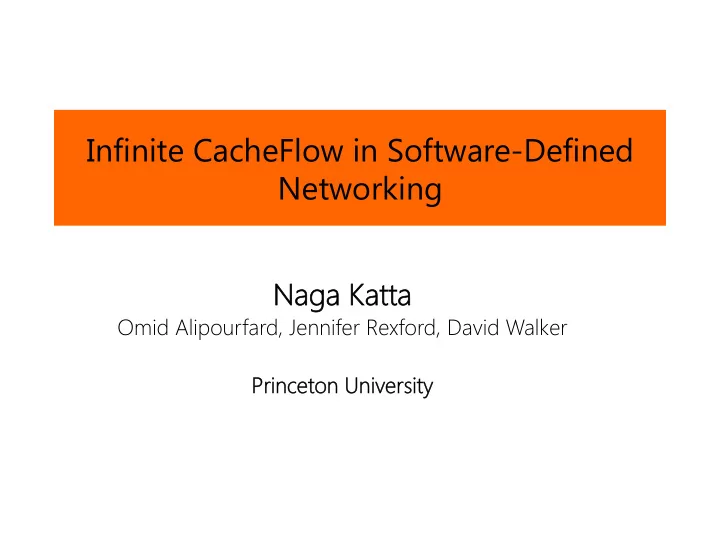

Infinite CacheFlow in Software-Defined Networking Na Naga Katta Omid Alipourfard, Jennifer Rexford, David Walker Princeton on University
Recent News 2
SDN Promises Flexible Policies Controller Switch TCAM 3
SDN Promises Flexible Policies Lot of fine- grained rules Controller Switch TCAM 4
SDN Promises Flexible Policies Lot of fine- grained rules Controller 5
SDN Promises Flexible Policies Lot of fine- grained rules Controller 6
SDN Promises Flexible Policies Lot of fine- grained rules Controller 7
SDN Promises Flexible Policies Controller Limited rule space! 8
SDN Promises Flexible Policies What now? Controller Limited rule space! 9
State of the Art Hardware Switch Software Switch Rule Capacity Low (~2K-4K) High Lookup Throughput High (>400Gbps) Low (~40Gbps) Port Density High Low Cost Expensive Relatively cheap 10
TCAM as cache Controller CacheFlow Software Switches S 1 S 2 TCAM 11
TCAM as cache Controller CacheFlow <5% rules cached S 1 S 2 TCAM 12
TCAM as cache Controller CacheFlow low expected cache-misses S 1 S 2 TCAM 13
TCAM as cache • High throughput + high rule space Controller CacheFlow S 1 S 2 TCAM 14
TCAM as cache • High throughput + high rule space Controller CacheFlow Flexible Deployment S 1 S 2 TCAM 15
A Correct , Efficient and Transparent Caching System • Abstraction of an “infinite” switch Ø Correct: realizes the policy Ø Efficient: high throughput & large tables Ø Transparent: unmodified applications/switches 16
1. Correct Caching
Caching under constraints Rule Match Action Priority Traffic R1 110 Fwd 1 3 10 R2 100 Fwd 2 2 60 R3 101 Fwd 3 1 30 Easy: Cache rules greedily 18
Caching Ternary Rules Rule Match Action Priority Traffic R1 11* Fwd 1 3 10 R2 1*0 Fwd 2 2 60 R3 10* Fwd 3 1 30 • Greedy strategy breaks rule-table semantics 19
Caching Ternary Rules Rule Match Action Priority Traffic R1 11* Fwd 1 3 10 R2 1*0 Fwd 2 2 60 R3 10* Fwd 3 1 30 Rules Overlap! • Greedy strategy breaks rule-table semantics 20
Caching Ternary Rules Rule Match Action Priority Traffic R1 11* Fwd 1 3 10 R2 1*0 Fwd 2 2 60 R3 10* Fwd 3 1 30 Rules Overlap! • Greedy strategy breaks rule-table semantics • Beware of switches that claim large rule tables 21
Dependency Graph R1 R4 Rule Match Action Priority Traffic R1 0000 Fwd 1 6 10 R2 R5 R2 000* Fwd 2 5 20 R3 00** Fwd 3 4 90 R3 R6 R4 111* Fwd 4 3 5 R5 11** Fwd 5 2 10 (*) R6 1*** Fwd 6 1 120 22
Dependent-Set Caching • All descendants in DAG are dependents • Cache dependent rules for correctness R1 R4 R2 R5 R3 R6 (*) 23
2. Efficient Caching
Dependent-Set Overhead Too Costly? R1 R4 R2 R5 R3 R6 (*) 25
Cover-Set Rule Match Action R4 R1 000 Fwd 1 R2 00* Fwd 2 R5 R1 R3 0** Fwd 3 R2 R5^ R4 11* Fwd 4 R5 1*0 Fwd 5 R3 R6 R5^ 1*0 To_SW R6 10* Fwd 6 (*) (*) *** To_SW Cover rule 26
Dependency Splicing reduces rule cost! Cover-Set Dependent-Set Rule Space Cost 27
Deep Dependency Chains – Clear Gain • ClassBench Generated ACL 100 % Cache-hit traffic 80 60 Cover-Set Algo 40 Dependent-Set Algo 20 0 0.5 1 2 5 10 25 50 % TCAM Cache Size (Log scale) 28
Shallow Dependency Chains – Marginal Gain • Stanford Backbone Routing table 100 % Cache-hit traffic 80 60 Dependent-Set Algo 40 Cover-Set Algo 20 0 1 2 5 10 25 50 % TCAM Cache Size (Log scale) 29
3. Transparent Caching
3. Transparent Design Controller OpenFlow Datapath CacheFlow S 1 S 2 S 3 S 4 HW_Cache ( TCAM ) 31
3. Transparent Design Controller OpenFlow Datapath CacheFlow Virtual switch S 1 S 2 S 3 S 4 HW_Cache ( TCAM ) 32
3. Transparent Design Emulates counters, barriers, timeouts etc. Controller OpenFlow Datapath CacheFlow Virtual switch S 1 S 2 S 3 S 4 HW_Cache ( TCAM ) 33
Conclusion • Rule caching for OpenFlow rules Ø Dependency analysis for corr correctness ectness Ø Splicing dependency chains for effi fficiency Ø Tr Transparent design 34
Infinite Ca$heFlow in SDN Question ons?
Recommend
More recommend